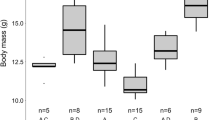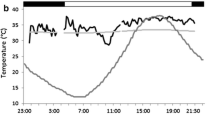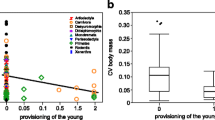Abstract
When females and males differ in their timing of maximum reproductive effort, this can result in sex-specific seasonal cycles in body mass. Such cycles are undoubtedly under strong selection, particularly in bats, where they affect flying ability. Flying foxes (Old World fruit bats, Pteropus spp.) are the largest mammals that can sustain powered flight and therefore face critical trade-offs in managing body reserves for reproduction, yet little is known about body mass dynamics in this group. I investigated body mass changes in relation to reproductive behaviour in a large colony of grey-headed flying foxes (Pteropus poliocephalus). In this polygynous mammal, females were predicted to maximise reproductive effort during lactation and males during the breeding season. As predicted, female body condition declined during the nursing period, but did not vary in relation to sexual activity. By contrast, males accumulated body reserves prior to the breeding season, but subsequently lost over 20% of their body mass on territory defence and courtship, and lost foraging opportunities as they also defended their day roost territories at night. Males in better condition had larger testes, particularly during territory establishment, prior to maximum sexual activity. Thus, the seasonality of female mass reflected the high metabolic load that lactation imposes on mothers. However, male mass followed a pattern akin to the “fatted male phenomenon”, which is commonly observed in large polygynous mammals with seasonal reproduction, but not in bats. This shows the importance of body reserves for reproduction in flying foxes, despite their severe constraints on body mass.




Similar content being viewed by others
References
Adkins-Regan E (2005) Hormones and animal social behavior. Princeton University Press, Princeton
Archer J (2006) Testosterone and human aggression: an evaluation of the challenge hypothesis. Neurosci Biobehav Rev 30:319–345
Atkinson SN, Ramsay MA (1995) The effects of prolonged fasting of the body composition and reproductive success of female polar bears (Ursus maritimus). Funct Ecol 9:559–567
Baptista TL, Richardson CS, Kunz TH (2000) Post-natal growth and age estimation in free-ranging bats: a comparison of longitudinal and cross-sectional sampling methods. J Mammal 81:709–718
Barclay RMR, Harder LD (2003) Life histories of bats: life in the slow lane. In: Fenton MB (ed) Ecology of bats. University of Chicago Press, Chicago, pp 209–253
Beck CA, Bowen WD, Iverson SJ (2003) Sex differences in the seasonal patterns of energy storage and expenditure in a phocid seal. J Anim Ecol 72:280–291
Bell G (1980) The costs of reproduction and their consequences. Am Nat 116:45–76
Brody S (1974) Bioenergetics and growth: with special reference to the efficiency complex in domestic animals. Hafner/Collier Macmillan, New York/London
Clutton-Brock TH, Parker GA (1992) Potential reproductive rates and the operation of sexual selection. Q Rev Biol 67:437–456
Clutton-Brock TH, Albon SD, Guinness FE (1989) Fitness costs of gestation and lactation in wild mammals. Nature 337:260–262
Crichton EG, Krutzsch PH (eds) (2000) Reproductive biology of bats. Academic, San Diego
Deutsch CJ, Haley MP, Le Boeuf BJ (1990) Reproductive effort of male northern elephant seals: estimates from mass loss. Can J Zool 68:2580–2593
Du Mond FV, Hutchinson TC (1967) Squirrel monkey reproduction: the “fatted” male phenomenon and seasonal spermatogenesis. Science 158:1067–1070
Duncan A, Baker GB, Montgomery N (1999) The action plan for Australian bats. Environment Australia, Canberra
Eby P (1991) Seasonal movements of grey-headed flying foxes, Pteropus poliocephalus (Chiroptera: Pteropodidae), from two maternity camps in northern New South Wales. Wildl Res 18:547–549
Eby P, Lunney D (2002) Managing the grey-headed flying fox, Pteropus poliocephalus as a threatened species: a context for the debate. In: Eby P, Lunney D (eds) Managing the grey-headed flying fox Pteropus poliocephalus as a threatened species in NSW. Royal Zoological Society of New South Wales, Mosman, pp 1–15
Encarnação JA, Dietz M, Kierdorf U, Wolters V (2004) Body mass changes in male Daubenton’s bats Myotis daubentonii (Chiroptera, Vespertilionidae) during the seasonal activity period. Mammalia 68:291–297
Forsyth DM, Duncan RP, Tustin KG, Gaillard J-M (2005) A substantial energetic cost to male reproduction in a sexually dimorphic ungulate. Ecology 86:2154–2163
Fujita MS, Tuttle MD (1991) Flying-foxes (Chiroptera: Pteropodidae): threatened animals of key ecological and economic importance. Conserv Biol 5:455–463
Gittleman JL, Thompson SD (1988) Energy allocation in mammalian reproduction. Am Zool 28:863–875
Gopalakrishna A, Chaudhari PN (1977) Breeding habits and associated phenomena in some Indian bats. Part 1. Rousettus leschenaulti (Desmarest). Megachiroptera. J Bombay Nat Hist Soc 74:1–16
Hall LS, Richards GC (2000) Flying foxes: fruit and blossom bats. University of New South Wales Press, Sydney
Hamilton IM, Barclay RMR (1998) Ontogenetic influences on foraging and mass accumulation by big brown bats (Eptesicus focus). J Anim Ecol 67:930–940
Hayssen V, Kunz TH (1996) Allometry of litter mass in bats: maternal size, wing morphology, and phylogeny. J Mammal 77:476–490
Hosken DJ (1998) Testes mass in megachiropteran bats varies in accordance with sperm competition theory. Behav Ecol Sociobiol 44:169–178
Hosken DJ, O’Shea JE (2001) Sperm production and immune function in two Australian bats, Chalinolobus morio and Nyctophilus geoffroyi. Ethol Ecol Evol 13:173–180
Kenagy GC (1976) The periodicity of daily activity and its seasonal changes in free-ranging and captive kangaroo rats. Oecologia 24:105–140
Klose SM, Welbergen JA, Goldizen AW, Kalko EKV (2009a) Spatio-temporal vigilance architecture of an Australian flying-fox colony. Behav Ecol Sociobiol 63:371–380
Klose SM, Welbergen JA, Kalko EKV (2009b) Testosterone is associated with harem maintenance ability in free-ranging grey-headed flying-foxes, Pteropus poliocephalus. Biol Lett 5:758–761
Koprowski JL (2005) Annual cycles in body mass and reproduction of endangered Mt. Graham red squirrels. J Mammal 86:309–313
Korine C, Speakman J, Arad Z (2004) Reproductive energetics of captive and free-ranging Egyptian fruit bats (Rousettus aegyptiacus). Ecology 85:220–230
Kunz TH, Parsons S (eds) (2009) Ecological and behavioral methods for the study of bats. Johns Hopkins Press, Baltimore
Kunz TH, Stern AA (1995) Maternal investment and post-natal growth in bats. In: Swift SM, Racey PA (eds) Symposia of the Zoological Society of London, vol 67. Clarendon, Oxford, pp 123–138
Kunz TH, Wrazen JA, Burnett CD (1998) Changes in body mass and fat reserves in prehibernating little brown bats (Myotis lucifugus). Ecoscience 5:8–17
Kurta A, Kunz TH, Nagy KA (1990) Energetics and water flux of free-ranging Big Brown Bats (Eptesicus fuscus) during pregnancy and lactation. J Mammal 71:59–65
Lindstedt SL, Boyce MS (1985) Seasonality, fasting endurance, and body size in mammals. Am Nat 125:873–878
Loudon ASI, Racey PA (eds) (1987) Reproductive energetics of mammals. Oxford University Press, Oxford
Lunney D, Richards G, Dickman C (2008) Pteropus poliocephalus. In: IUCN (ed) IUCN Red List of Threatened Species. IUCN, Gland
Maina JN (2000) What it takes to fly: the structural and functional respiratory refinements in birds and bats. J Exp Biol 203:3045–3064
Malo AF et al (2009) What does testosterone do for red deer males? Proc R Soc Biol Sci Ser B 276:971–980
Markus N (2002) Behaviour of the black flying fox Pteropus alecto. 2. Territoriality and courtship. Acta Chiropt 4:153–166
Markus N, Blackshaw JK (2002) Behaviour of the black flying fox, Pteropus alecto. 1. An ethogram of behaviour, and preliminary characterisation of mother-infant interactions. Acta Chiropt 4:137–152
Martin L et al (1995) The reproductive biology of Australian flying-foxes (genus Pteropus). In: Swift SM, Racey PA (eds) Symposia of the Zoological Society of London, vol 67. Clarendon, Oxford, pp 167–184
McGuckin MA, Blackshaw AW (1987) Seasonal changes in spermatogenesis (including germ cell degeneration) and plasma testosterone concentration in the Grey-headed fruit bat, Pteropus poliocephalus. Aust J Biol Sci 40:211–220
McGuckin MA, Blackshaw AW (1991a) Mating-associated peak in plasma testosterone concentration in wild male grey-headed flying foxes (Pteropus poliocephalus). J Reprod Fert 92:347–352
McGuckin MA, Blackshaw AW (1991b) Seasonal changes in testicular size, plasma testosterone concentration and body weight in captive flying foxes (Pteropus poliocephalus and P. scapulatus). J Reprod Fert 92:339–346
McLean JA, Speakman JR (1999) Energy budgets of lactating and non-reproductive brown long-eared bats (Plecotus auritus) suggest females use compensation in lactation. Funct Ecol 13:360–372
McNab BK (1976) Seasonal fat reserves of bats in two tropical environments. Ecology 57:332–338
Michener GR, Locklear L (1990) Differential costs of reproductive effort for male and female Richardson’s ground squirrels. Ecology 71:855–868
Miquelle DG (1990) Why don’t bull moose eat during the rut? Behav Ecol Sociobiol 27:145–151
Mitchell B, McCowan D, Nicholson IA (1976) Annual cycles of body weight and condition in Scottish red deer, Cervus elaphus. J Zool (Lond) 180:107–127
Nelson JEW (1964) Vocal communication in Australian flying foxes (Pteropodidae; Megachiroptera). Z Tierpsychol 27:857–870
Nelson JEW (1965a) Behavior of Australian pteropodidae (Megachiroptera). Anim Behav 13:544–557
Nelson JEW (1965b) Movements of Australian flying foxes (Pteropodidae: Megachiroptera). Aust J Zool 13:53–73
Norberg UM, Rayner JMV (1987) Ecological morphology and flight in bats (Mammalia; Chiroptera): wing adaptations, flight performance, foraging strategy and echolocation. Philos Trans R Soc Lond B Biol Sci 316:335–427
O’Brien GM (1993) Seasonal reproduction in flying foxes, reviewed in the context of other tropical mammals. Reprod Fertil Dev 5:499–521
Olsson M, Madsen T, Shine R (1997) Is sperm really so cheap? Costs of reproduction in male adders, Vipera berus. Proc R Soc Lond B Biol Sci 264:455–459
Parry-Jones KA, Augee ML (1992) Movements of grey-headed flying-foxes (Pteropus poliocephalus) to and from a colony site on the central coast of New South Wales. Wildl Res 19:331–340
Puddicombe R (1981) A behavioural study of the Grey-Headed Flying Fox, Pteropus poliocephalus (Megachiroptera) (BSc Hons thesis). University of New England, Armidale
Racey PA (1982) The ecology of bat reproduction. In: Kunz TH (ed) The ecology of bats. Plenum, New York, pp 57–104
Racey PA, Speakman JR (1987) The energy costs of pregnancy and lactation in heterothermic bats. Symp Zool Soc Lond 54:107–125
Ratcliffe F (1932) Notes on the fruit bats (Pteropus spp.) of Australia. J Anim Ecol 1:32–57
Reeder DM, Kosteczko NS, Kunz TH, Widmaier EP (2006) The hormonal and behavioral response to group formation, seasonal changes, and restraint stress in the highly social Malayan Flying Fox (Pteropus vampyrus) and the less social Little Golden-mantled Flying Fox (Pteropus pumilus) (Chiroptera: Pteropodidae). Horm Behav 49:484–500
Schulte-Hostedde AI, Millar JS, Hickling GJ (2005a) Condition dependence of testis size in small mammals. Evol Ecol Res 7:143–149
Schulte-Hostedde AI, Zinner B, Millar JS, Hickling GJ (2005b) Restitution of mass-size residuals: validating body condition indices. Ecology 86:155–163
Speakman J, Racey P (1986) The influence of body condition on sexual development of male brown long-eared bats (Plecotus auritus) in the wild. J Zool (Lond) 210:515–525
Speakman JR, Rowland A (1999) Preparing for inactivity: how insectivorous bats deposit a fat store for hibernation. Proc Nutr Soc 58:123–131
Spencer HJ, Palmer C, Parry-Jones K (1991) Movements of fruit bats in eastern Australia, determined by using radio-tracking. Wildl Res 18:463–468
Stearns SC (1992) The evolution of life histories. Oxford University Press, Oxford
Temminck CJ (1825) Vues générales sur l’ordre des cheiroptères. In: Temminck CJ (ed) Monographies de mammalogie, ou description de quelques genres de mammifères, dont les espèces dont été observées dans les différens musées de l’Europe. G. Dufour & E. D’Ocagne, Paris, pp 157–204
Thomas DW, Marshall AG (1984) Reproduction and growth in three species of West African fruit bats. J Zool (Lond) 202:265–281
Vardon MJ, Tidemann CR (1998) Reproduction, growth and maturity in the black flying-fox, Pteropus alecto (Megachiroptera: Pteropodidae). Aust J Zool 46:329–344
Voigt CC (2003) Reproductive energetics of the nectar-feeding bat Glossophaga soricina (Phyllostomidae). J Comp Physiol B Biochem Syst Environ Physiol 173:79–85
Welbergen JA (2005) The social organisation of the grey-headed flying-fox (Ph.D thesis). University of Cambridge, Cambridge
Welbergen JA (2006) Timing of the evening emergence from day roosts of the grey-headed flying-fox, Pteropus poliocephalus: the effects of predation risk, foraging needs and social context. Behav Ecol Sociobiol 60:311–322
Welbergen JA (2008) Variation in twilight predicts the duration of the evening emergence of fruit bats from a mixed-species roost. Anim Behav 75:1543–1550
Welbergen JA (2010) Growth, bimaturation and sexual size dimorphism in wild gray-headed flying-foxes (Pteropus poliocephalus). J Mammal 91:38–47
Welbergen JA, Klose SM, Markus N, Eby P (2008) Climate change and the effects of temperature extremes on Australian flying-foxes. Proc R Soc Biol Sci Ser B 275:419–425
Wolff JO (1998) Breeding strategies, mate choice, and reproductive success in American bison. Oikos 83:529–544
Acknowledgments
I am very grateful to N. Davies, T. H. Clutton-Brock, and P. Racey for their constructive comments on earlier versions of the manuscript. I thank S. Klose and T. Sinclair-Taylor for their help in the field; A. Goldizen for her academic support; and G. H. Williams for access to the Dallis Park property. This work was supported in part by studentships from the Natural Environment Research Council, King’s College, the Isaac Newton Trust, and the Cambridge European Trust. All procedures used in this study were under permit and in accordance with the principles and guidelines of the Australian Bird and Bat Banding Scheme, NSW Parks and Wildlife Service, and NSW Department of Agriculture.
Author information
Authors and Affiliations
Corresponding author
Additional information
Communicated by Elisabeth Kalko.
Rights and permissions
About this article
Cite this article
Welbergen, J.A. Fit females and fat polygynous males: seasonal body mass changes in the grey-headed flying fox. Oecologia 165, 629–637 (2011). https://doi.org/10.1007/s00442-010-1856-1
Received:
Accepted:
Published:
Issue Date:
DOI: https://doi.org/10.1007/s00442-010-1856-1




